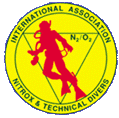Home
About Us
Learn To Dive
Deeper Into Diving
Popular Specialties
Technical Training
PADI
IANTD
Rebreathers
OE.edu
Q & A
Equipment
Travel
Local Diving
Calendar
Contact
NEWSLETTER

Ocean Explorers Aquatic Center
732-906-8400
180 Lafayette Avenue
Edison, New Jersey 08837
Hours:
Tue - Fri 12:30 - 7:30 p.m.
Sat 12:30 - 5 p.m.
MAP & DIRECTIONS
|

IANTD Technical Training
Advanced Nitrox
The Advanced Nitrox diver program is designed to extend your knowledge in the use of Nitrox for sport diving.
If further develops diving skills and provides greater understanding of the use of oxygen enriched air. You will learn the benefits and potential hazards of using up
to 50% Nitrox. Although IANTD considers this a sport diving course, limited decompression is introduced.
This is a favorite program at Ocean Explorers. We consider it one of
the most practical for the kind of diving most of us are doing. It is a prerequisite for all technical diving and closed circuit rebreather diving. You can take this
course in traditional sport diving equipment. If you plan to continue your training you can use technical diving gear such as double tanks, backplate and harness.
Course Start Dates
Recreational Trimix
This newest IANTD course leads to a certification for the recreational use of trimix. The maximum depth for the training and certification is 130 feet. What equipment do you
need: You can use all of your own standard recreational SCUBA equipment . There is no requirement for special equipment as there is for the extended range trimix certification
courses Pre-requisites: Divers must be Advanced Open water certified as well as Nitrox. The Advanced Nitrox class can be taken in conjunction with the recreational trimix
course. This would result in an Advanced Recreational Trimix certification. The mixes we will use will be on the order of 30-32% Oxygen & 30% Helium.
One advantage for using Helium is that if you experience narcosis at 100-130 feet the Helium content will reduce the
narcosis considerably. Breathing Helium also helps reduce breathing resistance because Helium is much less dense than the other gases we typically breathe. This may improve
your gas consumption rate resulting in longer bottom times.
Normoxic Trimix Diver
The IANTD Normoxic Trimix Diver program is aimed at those who wish to dive in the zone between 130 fsw (39 msw) and 200 fsw (60 msw) but are not comfortable doing so on air.
The course uses normoxic mixtures and consists of 12 dives and one three (3) hour confined water session. Six (6) dives are on air to depths between 100 fsw (30 msw) and 130
fsw (39 msw) and six (6) dives involve practicing specified skills at depths between 30 fsw (9 msw) and 90 fsw (27 msw). All dives will be performed with two (2) stage
cylinders. Four (4) Trimix dives are also made in the course with two (2) at depths up to 165 fsw (50 msw) and two (2) at depths up to 200 fsw (60 msw). This is an intense
seven (7) day program enabling the graduate to be qualified to dive normoxic Trimix to 200 fsw (60 msw). It does not qualify the diver to use hypoxic mixtures to participate in
dives deeper than 200 fsw (60 msw). The text for the course is IANTD's Technical Diver Encyclopedia, associated Technical Diver Workbook, Slides and newly developed Water-proof
Tables
Technical Diver
This program provides training for divers to carry out dives to 170’ using custom blend mixes. It provides greater understanding of the mixes to achieve the dive objectives.
You will also get a complete knowledge of the limits of any Nitrox mixture and the use of high oxygen decompression gasses. You will learn the basics of gas blending, tracking
your oxygen uptake, planning CNS values, O2 cleaning and maintenance of equipment and field operational procedures.
|

